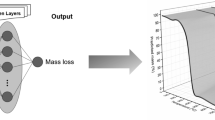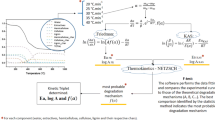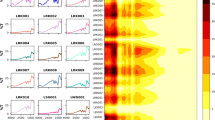Abstract
Vegetal fibers can be applied in several areas, from the medical field to the development of new advanced materials. They have a complex chemical structure including cellulose, hemicellulose, and lignin. Each component plays a different role in the thermal degradation. Apart from it, this study aims to simulate and predict different ratios of cellulose/hemicellulose/lignin in the thermal degradation behavior of a vegetal fiber. This study was divided into two distinct parts: (i) firstly, the thermogravimetric curves (TG) were simulated based on their chemical composition to verify the influence of each component ratio in the degradation behavior. Briefly, 100% hemicellulose sample showed the lowest Tonset, 100% lignin sample showed the highest residue, and 100% cellulose sample showed the lowest residue at 600 °C among all samples studied. (ii) Secondly, a prediction of the thermal behavior for any combination of cellulose, hemicellulose, and lignin was performed by using an artificial neural network (ANN) combined with a surface response methodology (SRM). The prediction curves presented high reliability with the experimental fit, which allowed the thermal degradation behavior prediction of a vegetal fiber with any cellulose, hemicellulose, and lignin ratio.
Graphical abstract

Similar content being viewed by others
References
Ali I, Bahaitham H, Naebulharam R (2017) A comprehensive kinetics study of coconut shell waste pyrolysis. Bioresour Technol 235:1–11. https://doi.org/10.1016/j.biortech.2017.03.089
Angrizani CC, Ornaghi HL Jr, Zattera AJ, Amico SC (2016) Thermal and mechanical investigation of interlaminate glass/curaua hybrid polymer composites. J Nat Fibers 14:271–277. https://doi.org/10.1080/15440478.2016.1193091
Barana D, Ali SD, Salanti A, Orlandi M, Castellani L, Hanel T, Zoia L (2016) Influence of lignin features on thermal stability and mechanical properties of natural rubber compounds. ACS Sustain Chem Eng 4:5258–5267. https://doi.org/10.1021/acssuschemeng.6b00774
Van Boekel MAJS (1996) Statistical aspects of kinetic modeling for food science problems. J Food Sci 61:477–486. https://doi.org/10.1111/j.1365-2621.1996.tb13138.x
Borsoi C, Ornaghi HL Jr, Scienza LC, Zattera AJ, Ferreira CA (2017) Isolation and characterisation of cellulose nanowhiskers from microcrystalline cellulose using mechanical processing. Polym Polym Compos 25:563–570. https://doi.org/10.1177/096739111702500801
Burguillo FJ, Wright AJ, Bardsley WG (1983) Use of the F test for determining the degree of enzyme-kinetic and ligand-binding data. A Monte Carlo simulation study. Biochem J 211:23–34. https://doi.org/10.1042/bj2110023
Cabeza A, Sobrón F, Yedro FM, García-Serna J (2015) Autocatalytic kinetic model for thermogravimetric analysis and composition estimation of biomass and polymeric fractions. Fuel 148:212–225. https://doi.org/10.1016/j.fuel.2015.01.048
Conesa JA, Caballero JA, Reyes-Labarta JA (2004) Artificial neural network for modelling thermal decompositions. J Anal Appl Pyrolysis 71:343–352. https://doi.org/10.1016/s0165-2370(03)00093-7
Dall Agnol L, Ornaghi HL Jr, Monticeli FM, Dias FTG, Bianchi O (2021) Polyurethanes synthetized with polyols of distinct molar masses: use of the artificial neural network for prediction of degree of polymerization. Polymer Eng Sci 61:1810–1818. https://doi.org/10.1002/pen.25702
Frigerio P, Zoia L, Orlandi M, Hanel T, Castellani L (2014) Application of sulphur-free lignins as a filler for elastomers: effect of hexamethylenetetramine treatment. Bioresources 9:1387–1400. https://doi.org/10.15376/biores.9.1.1387-1400
Gong X, Yu Y, Gao X, Qiao Y, Xu M, Wu H (2014) Formation of anhydro-sugars in the primary volatiles and solid residues from cellulose fast pyrolysis in a wire-mesh reactor. Energy Fuels 28:5204–5211. https://doi.org/10.1021/ef501112q
Hosoya T, Kawamoto H, Saka S (2007) Cellulose–hemicellulose and cellulose–lignin interactions in wood pyrolysis at gasification temperature. J Anal Appl Pyrolysis 80:118–125. https://doi.org/10.1016/j.jaap.2007.01.006
Kleen M, Gellerstedt G (1995) Influence of inorganic species on the formation of polysaccharide and lignin degradation products in the analytical pyrolysis of pulps. J Anal Appl Pyrolysis 35:15–41. https://doi.org/10.1016/0165-2370(95)00893-j
Lazzari LK, Zampieri VB, Neves RM, Zanini M, Zattera AJ, Baldasso C (2018) A study on adsorption isotherm and kinetics of petroleum by cellulose cryogels. Cellulose 26:1231–1246. https://doi.org/10.1007/s10570-018-2111-x
Monticeli FM, Almeida Jr. JHS, Neves RM, Ornaghi FG, Ornaghi Jr. HL (2020) On the 3D void formation of hybrid carbon/glass fiber composite laminates: a statistical approach. Compos Part A Appl Sci Manuf 137:106036. https://doi.org/10.1016/j.compositesa.2020.106036
Monticeli FM, Neves RM, Ornaghi Jr. HL (2021) Using an artificial neural network (ANN) for prediction of thermal degradation from kinetics parameters of vegetable fibers. Cellulose. https://doi.org/10.1007/s10570-021-03684-2
Neves RM, Lopes KS, Zimmermann MVG, Poletto M, Zattera AJ (2019) Characterization of polystyrene nanocomposites and expanded nanocomposites reinforced with cellulose nanofibers and nanocrystals. Cellulose 26:4417–4429. https://doi.org/10.1007/s10570-019-02392-2
Neves RM, Silveira Lopes K, Zimmermann MGV, Poletto M, Zattera AJ (2019) Cellulose nanowhiskers extracted from tempo-oxidized curaua fibers. J Nat Fibers 17:1355–1365. https://doi.org/10.1080/15440478.2019.1568346
Ornaghi HL Jr, Ornaghi FG, de Carvalho Benini KCC, Bianchi O (2019) A comprehensive kinetic simulation of different types of plant fibers: autocatalytic degradation mechanism. Cellulose 26:7145–7157. https://doi.org/10.1007/s10570-019-02610-x
Ornaghi HL Jr, Ornaghi FG, Neves RM, Monticeli F, Bianchi O (2020) Mechanisms involved in thermal degradation of lignocellulosic fibers: a survey based on chemical composition. Cellulose 27:4949–4961. https://doi.org/10.1007/s10570-020-03132-7
Pecha B, Garcia-Perez M (2015) Pyrolysis of lignocellulosic biomass. Bioenergy, 413–442. https://doi.org/10.1016/b978-0-12-407909-0.00026-2
Poletto M (2016) Thermal degradation and morphological aspects of four wood species used in lumber industry. Rev Arvore 40:941–948. https://doi.org/10.1590/0100-67622016000500018
Poletto M, Ornaghi Jr. HL (2015) Cellulose: fundamental aspects and current trends. BoD–Books on Demand. https://doi.org/10.5772/59889
Poletto M, Ornaghi HL Jr, Zattera AJ (2014) Native cellulose: structure, characterization and thermal properties. Materials (Basel) 7:6105–6119. https://doi.org/10.3390/ma7096105
Rostami S, Ahmadi-Danesh-Ashtiani H, Toghraie D, Fazaeli R (2020) A statistical method for simulation of boiling flow inside a Platinum microchannel. Physica A 548:123879. https://doi.org/10.1016/j.physa.2019.123879
Sánchez-Jiménez PE, Pérez-Maqueda LA, Perejón A, Criado JM (2013) Limitations of model-fitting methods for kinetic analysis: polystyrene thermal degradation. Resour Conserv Recycl 74:75–81. https://doi.org/10.1016/j.resconrec.2013.02.014
Schmidhuber J (2015) Deep learning in neural networks: an overview. Neural Netw 61:85–117. https://doi.org/10.1016/j.neunet.2014.09.003
Sunphorka S, Chalermsinsuwan B, Piumsomboon P (2017) Artificial neural network model for the prediction of kinetic parameters of biomass pyrolysis from its constituents. Fuel 193:142–158. https://doi.org/10.1016/j.fuel.2016.12.046s
Vyazovkin S, Burnham AK, Criado JM, Pérez-Maqueda LA, Popescu C, Sbirrazzuoli N (2011) ICTAC Kinetics Committee recommendations for performing kinetic computations on thermal analysis data. Thermochim Acta 520:1–19. https://doi.org/10.1016/j.tca.2011.03.034
Woolf D, Amonette JE, Street-Perrott FA, Lehmann J, Joseph S (2010) Sustainable biochar to mitigate global climate change. Nat Commun 1:56. https://doi.org/10.1038/ncomms1053
Yang H, Yan R, Chen H, Zheng C, Lee DH, Liang DT (2006) In-depth investigation of biomass pyrolysis based on three major components: hemicellulose, cellulose and lignin. Energy Fuels 20:388–393. https://doi.org/10.1021/ef0580117
Yao F, Wu Q, Lei Y, Guo W, Xu Y (2008) Thermal decomposition kinetics of natural fibers: activation energy with dynamic thermogravimetric analysis. Polym Degrad Stab 93:90–98. https://doi.org/10.1016/j.polymdegradstab.2007.10.012
Zanchet A, Demori R, de Sousa FDB, Ornaghi HL Jr, Schiavo LSA, Scuracchio CH (2019) Sugar cane as an alternative green activator to conventional vulcanization additives in natural rubber compounds: thermal degradation study. J Clean Prod 207:248–260. https://doi.org/10.1016/j.jclepro.2018.09.203
Zhang J, Choi YS, Yoo CG, Kim TH, Brown RC, Shanks BH (2015) Cellulose–hemicellulose and cellulose-lignin interactions during fast pyrolysis. ACS Sustain Chem Eng 3:293–301. https://doi.org/10.1021/sc500664h
Acknowledgements
The authors acknowledge Brazilian Agency Coordenação de Aperfeiçoamento de Pessoal de Nível Superior (CAPES, Brazil)—(Finance Code 001) and Fundação de Amparo à Pesquisa do Estado de São Paulo (FAPESP).
Author information
Authors and Affiliations
Corresponding author
Additional information
Publisher's note
Springer Nature remains neutral with regard to jurisdictional claims in published maps and institutional affiliations.
Rights and permissions
About this article
Cite this article
Ornaghi, H.L., Monticeli, F.M., Neves, R.M. et al. Influence of different cellulose/hemicellulose/lignin ratios on the thermal degradation behavior: prediction and optimization. Biomass Conv. Bioref. 13, 7775–7782 (2023). https://doi.org/10.1007/s13399-021-01651-2
Received:
Revised:
Accepted:
Published:
Issue Date:
DOI: https://doi.org/10.1007/s13399-021-01651-2









